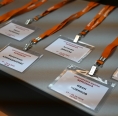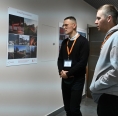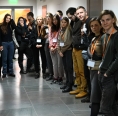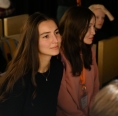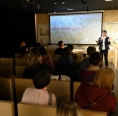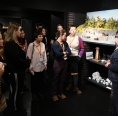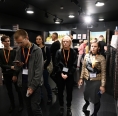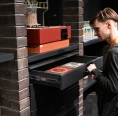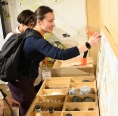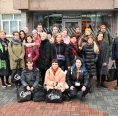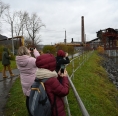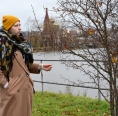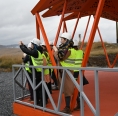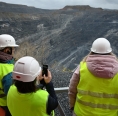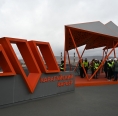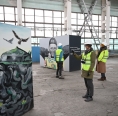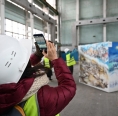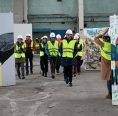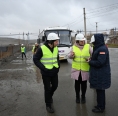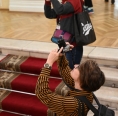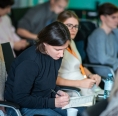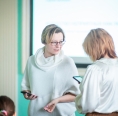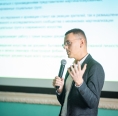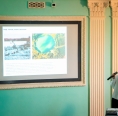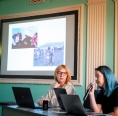-
EDUCATIONAL PROGRAM AND PROJECT COMPETITION OF CURATORIAL TRAINING NEMOSKVA HAVE COME TO A CLOSE
The Curatorial Training NEMOSKVA took place in the city of Satka from October 14 to October 28, 2019. Twenty participants selected through competition have completed the educational program and developed and defended their projects of future curatorial exhibits for various regions of Russia. All of the projects prepared in the course of the Training were accepted for participation in the Competition, voting for which finished on November 12.
The major objective of the School is to find and train curators for implementation of exhibit projects in Russian provinces and to improve the quality of curatorial expertise for further national and international projects.
The educational course was developed considering the needs of regional specialists. The program included seven original courses developed specially for the Training by such lecturers as: Victor Misiano – curator, lecturer at the Higher School of Economics, founder and chief editor of Moscow Art Magazine, Russia; Dieter Roelstraete – curator of Documenta 14, curator and lecturer at the University of Chicago, Belgium; Valentinas Klimašauskas – curator, writer, co-curator of the Latvian national pavilion at the Venice Biennale 2019, Lithuania; Simon Sheikh – curator, art theorist, member of the work group of the Bergen Assembly, director of MA program in Curating at Goldsmiths College, University of London, the UK; Mikhail Durnenkov – playwright, screenwriter, member of the New Drama movement, co-organizer of the Lyubimovka Festival of Young Drama, Russia; Ilya Budraitskis – historian, social theorist, art critic, Editorial Board member of Moscow Art Magazine, Russia; Alla Mitrofanova – philosopher, curator, culture expert, co-founder of the Cyber-feminist Internationale.
Maria Kalinina, head of the regional development department of the National Centre for Contemporary Arts, curator and co-organizer of the MediaUdar activist art festival, Editorial Board member of Moscow Art Magazine, suggested the topic of the Training “The Art of Document: The Poetics of Evidence”. The Training attendees were offered to study a wide range of issues of documentation and new forms of “realism” as key tools for interaction with the relevant art agenda. Such work with a document or a fact has the potential for curatorial experiments, even in the absence of a professional platform and with limited resources.
Aspects of project management in the field of exhibit organization were addressed in the course of workshops of Anastasia Lomonosova, executive director of the NEMOSKVA project.
Under the aegis of the Curatorial Training several public events were held for the residents of Satka: Victor Misiano’s lecture “The 90’s: Dialectics of the Transition Period from Nowhere to Nowhere”; Antonio Geusa’s lecture “Press Rec: Tell the Truth”; two public screenings of the video art series “Eco Echo” on the topic of ecology.
The parallel program of the Training included trips to natural and cultural places of interest of Satkinsky District and the Chelyabinsk Region: Zyuratkul National Park, Ay Pritecy (cliffs at the Ay River), power station “Porogi” (the Rapids), the Karagaysky open-cut mine, as well as art objects created during the Satka Street Art Fest.
Here are some selected comments of the project lecturers and participants:
Dieter Roelstraete: “Any artist is a local artist. For example, New York is actually a very provincial city, restricted in many ways, and Andy Warhol was an extremely local artist who could create his art works only in that specific place and at that specific time. Thus, all artists, to a certain extent, conceive regional, local issues. What is important is not how far from the center you are, but how well aware of and connected to the general context you are.
The future of regional development is associated with informing yourself and people around you. You don’t have to visit the center on a regular basis; I was very impressed by how easily two participants of the Curatorial Training, one from Yakutsk and another from Rostov-on-Don, reflected on a global scale and how well aware they are of the global context of contemporary arts. I believe it is not very problematic to reside in Barnaul and to be aware of what happens elsewhere. This is the purpose of curator work in regions – to provide information and to educate people around you. As a curator, you should understand global processes and be familiar with the worldwide context, you cannot work in isolation.”
Ilya Budraitskis: “In any case art works with a community and, even though it speaks a universal language of a kind, it still engages in a dialogue with the audience and with certain people and is associated with a specific place. In fact, it was noticeable during communication with the students of the Training, in the projects they were working on, because obviously they were all highly involved into those practices which connect them to the place where they live and work. However, this practice itself doesn’t provide an exhaustive insight into what art is and what methods it uses. Thus, I think the dialogue we have had during this Training is of great significance. And I hope it will really push forward the activity of each person who came here.”
Valentinas Klimašauskas: “I believe that starting with Marshall McLuhan’s theories formulated in 60–70s we live in a “global village”. Moreover, today we have the Internet, and if we are willing to be involved into the general context, we do not have to stay in cultural capitals, like the ones Paris or New York used to be before the XX century. Language of contemporary art is universal, however it always has its authenticity which attributes it to a specific place. Therefore, art shall be global, but its features will always be local. I do not believe that the language of contemporary art shall be completely comprehensible, because our life abounds with things that can’t be articulated. Hence, curators are faced with the question of how we can articulate something non-articulable, and how to do it globally while staying local.”
Maria Filatova, participant of the Training, employee of the North-Caucasus Branch of the National Centre for Contemporary Arts, Vladikavkaz: “As there is no curatorial environment in Vladikavkaz, it is difficult there to adopt somebody’s practices of implementing ideas. And I don’t have any chance to discuss my projects to understand whether my ideas are relevant at all, while here I felt assured that my ideas are valuable and may be implemented in practice, and moreover, they will be valuable to the local environment in which they will be implemented. Here I got such a boost, that I want to return home and to proceed on my project immediately. And I hope that there will be other Schools and it is not my last time here.”
Sergey Balandin, participant of the Training, curator of the Viktoria Art Gallery, Samara: “Initially I was interested in the Training’s educational program, the announced team of lecturers and the topic which concerns me. On my way here, I understood that I definitely needed that program, but I didn’t think much about the project competition. However, I liked to observe my fellow students, participants of the Training, expressing themselves and developing understanding of their projects and curatorial work in general. I am in sympathy with some projects. We shared our experience not just with the lecturers, but also with each other, and I learned from other participants of the Training.”
The Curatorial Training focus on practical work is intended to increase the number of exhibit projects in various regions. The participants had been developing curatorial concepts of exhibits for two weeks and defended them before the Training experts at the end of the program. The jury included the lecturers of the Curatorial Training and representatives of major funds, partners of the NEMOSKVA project, interested in implementation of outstanding cultural projects in Russian regions.
A strategic partner of the NEMOSKVA project – The Vladimir Potanin Foundation, has many times supported key events of the project within the program “Museums without Borders”.
“The Curatorial Training of the NEMOSKVA project is an initiative which contributes to generation and development of ideas of contemporary art exhibit projects in Russian regions. The first experience of holding the Training in Satka last October showed that although there was a number of curatorial trainings in Russia, the interest in the profession of independent curator, its relevance and demand for new knowledge is still high. It is important that the attempt to understand what constitutes curatorial work, what is currently interesting and important to discuss and what curatorial approaches may be used for that, was successful – during practical work on their projects the participants successfully defended them and received feedback from the Training experts. We also support the idea of the NEMOSKVA project team to arrange the Curatorial Training in the future in various parts of our country, which will definitely bring together people with different experience and train professionals able to work in changing environments,” said Oksana Fodina, program director of the Vladimir Potanin Foundation.
SIBUR is an official partner of NEMOSKVA project since 2018 under its social investment program “Formula for Good Deeds”. Sharing the objectives and the mission of the NEMOSKVA project, the company seeks to create comfortable environment in the company’s cities of operation and to generate busy and relevant agenda in the cultural sphere. Over two years, the NEMOSKVA delegation visited 6 cities of SIBUR’s operation: Nizhny Novgorod, Krasnoyarsk, Perm, Tyumen, Tobolsk and Tomsk. Visits to the cities included reviews of ideas of local artists, educational lectures, discussions and round-table conferences.
Stanislav Kasparov, Director, Business support in the cities of operation: “Such projects as NEMOSKVA carry out an extremely important mission. They do not just shape the cultural agenda, but also allow various cities of Russia to become attraction points notable not only regionally, but nationwide. It is very important to us that such approach yields a long-term effect, awakening creative powers at the local level and contributing to creation of new local cultural products. We wish all participants of the Curatorial Training success in implementation of their plans!”
In 2019, the Magnezit Group became a co-organizer of the Curatorial Training. The Company’s projects implemented in Satka, a city well-known for its unique social and cultural environment, include: cooperation with the State Russian Museum; International Festival of Classical Music of E.V. Obraztsova “Carmen”; International Architectural Festival “My Satka”; International Street Art Festival “Satka Street Art Fest”.
Natalia Nikiforova, Director of the Corporate Development and Strategic Communications Department of the Magnezit Group: “The experience of arranging the Curatorial Training in Satka turned out to be interesting and rather productive. Along with basic knowledge, the lecturers presented the latest materials summarizing modern tendencies and best practices of implementing exhibit projects, students demonstrated sincere interest and capacity for self-development. As a result, the issues of documentation and new forms of “realism” as key tools for interaction with the relevant art agenda proposed by the organizers were comprehensively explored. I think, the knowledge obtained by the students of the Satka Training will transform into practical experience in Russian regions and turn into new curatorial programs.”
The conclusions drawn based on the results of the Curatorial Training will be presented during a discussion titled “NEMOSKVA Platform. Problematics of Curatorial Work in Regions: Independent and Museum Practices” at St. Petersburg International Cultural Forum on November 15, 2019. The discussion will cover specific aspects of educational programs for local specialists, as well as will suggest positive corrective actions for development of the School’s curriculum in the future. The Curatorial School will continue its educational work in the traveling manner: in the coming years the Training will start operation in other regions and its location will affect the content of educational and research programs.
In addition, the names of the finalists of the NEMOSKVA Curatorial Training Project Competition will be announced at the Forum.
______________________________________________________
The regional art development platform NEMOSKVA was initiated in 2017 as a strategic project for development of contemporary culture in Russian regions during the period of 2018–2022. Its purpose is development of horizontal links, promotion of regional artists and curators, exploration of current situation at the local level via professional dialogue and creation of new possibilities for international cooperation. The commissioner and the author of the idea of the NEMOSKVA project is Alisa Prudnikova, an art expert and curator, commissioner and art director of the Ural Industrial Biennale of Contemporary Art, Director for Regional Development of ROSIZO-NCCA.
In August–September 2018 an International Traveling Symposium along the Trans-Siberian Railway was held. Based on the results of reviews of art project ideas in 12 cities of the trip, data on 289 unimplemented projects of regional artists was collected. Over the time of its existence, the project united more than 60 foreign and more than 70 Russian heads of cultural institutions, curators, practitioners and theorists of contemporary culture.
In March 2019, a limited edition of “NEMOSKVA. Travel Diaries” collection was published. 13 curators shared their thoughts on the journey of incredible scale and concept, with each curator choosing one city to describe.
On June 27, an exhibit “The 12th Time Zone” took place in the BOZAR Centre for Fine Arts. It contained 12 works of regional artists. The exhibit was curated by Inke Arns, Director of HMKV Media Art Association, and Dieter Roelstraete, co-curator of Documenta 14, curator of the Neubauer Collegium for Culture and Art at the University of Chicago.
Photos by Vasiliy Maksimov and Denis Shakirov.
-
26.08 - 26.08
DIARY OF THE THIRD INDUSTRIAL BIENNALE
-
28.11 - 28.11
MY SATKA FESTIVAL WINS THE CONTEST OF CORPORATE VOLUNTEER PROJECTS
-
13.10 - 15.10
COOPERATION WITH VGIBL NAMED AFTER M.I. RUDOMINO


